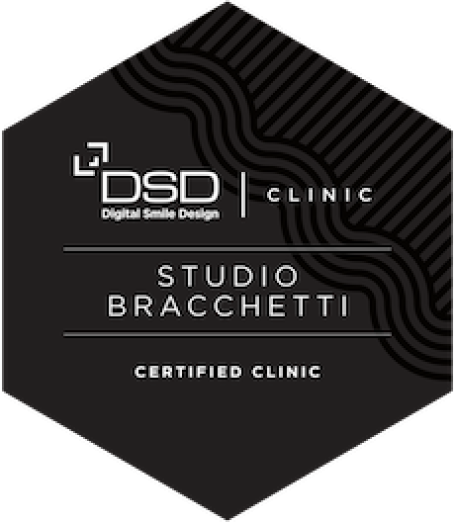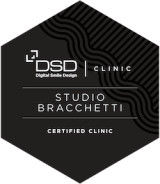Mucogingival surgery
Mucogingival surgery, also known as periodontal plastic surgery, includes a set of techniques aimed at increasing the volume of the gums and solving some functional and aesthetic problems of the soft tissues.
For example, these surgeries are carried out when gingival recessions occur, ie alterations in which the gum migrates (rises) towards the apex of the tooth.
Other examples of mucogingival surgery, in addition to root coverage, are all the procedures that are carried out to obtain an aesthetic harmony of the gingival parables of the smile, the improvement/ resolution of aesthetic defects around natural teeth and implants even in the presence of vertical bone defects in these areas, and the increase in the ridge i.e. the increase in gingival thickness, optimizing the presence of mucosa and especially keratinized gingival tissue.
These issues arise for various reasons. At the Bracchetti Dental Clinic in Milan we deal with mucogingival surgery to correct the various defects caused by gingival recession. We also use innovative and the most up-to-date techniques to solve these important ailments.
Gingival recessions and mucogingival surgery
Gingival recessions can lead to various aesthetic problems in the frontal part of the oral cavity, as well as an increase in dental sensitivity. Tooth decay and root abrasions are also frequent and should be treated at the same time as root coverings. In addition to the aesthetic aspect there are also functional problems. A healthy mouth is essential for our physical and psychological well-being.
The importance of having a healthy smile is fundamental both for the functions of the mouth (chewing, speech, etc.) and for having a beautiful smile.
Mucogingival surgery aims to solve these problems, making sure that the gum returns to cover the tooth. Very often the gingival tissues are increased by taking a piece of mucosa from the palate to be used as a graft in the tooth to be treated.
The gums are a fundamental part of the mouth as they protect against the entry of food residues and bacteria between the teeth. Additionally, together with the bone, they support the teeth preventing their detachment and possible fall, the last stage of processes neglected over time.
This surgery can be performed around natural teeth, implants and prosthetic elements. Some of the techniques usually employed by us are the following:
- Coronal Sliding Flap
- Trapeizodal flap
- Triangular flap
- Connectival Graft
- Coronal Sliding Flap + Connective Graft
- Connective Epithelial Graft or Free Grafts
- Bilaminar technique.
The connective tissue graft consists of a removal of connective tissue from an area of the oral cavity applied to a recipient area. The graft can be taken from the tuber area, from the palate and from the thickness of the edentulous saddles (areas where there are missing teeth). The sampling techniques are distinguished according to the healing to be obtained. In the case of primary intentional healing, trap-door, L-shaped and envelope techniques are used.
The technique of Connective Epithelium Removal is most commonly used in the Bracchetti Clinic followed by a second intention healing. This technique allows for a more superficial connective tissue sampling with higher quality and less pain post-operative for the patient.
With these techniques we take a connective tissue graft and apply it in correspondence to a root recession and then this graft is covered with a flap obtained in the apical area above the recession, or from the lateral tissue to the recession. This technique has considerable aesthetic advantages compared to the techniques used previously, as the gingival tissues at the end of healing are uniform in appearance and color to the adjacent gum.
It is essential to create optimal flap stabilization and primary closure to restore the size and position of the lost gingiva.
Each of these techniques we adopt on a case-by-case basis has the goal of achieving maximum results. Clearly, before proceeding with the surgery, we will carry out a visit to accurately determine the specific situation of the patient and the best results that can be objectively achieved in each specific case.
Gingival recessions causes and prevention
For any disorder affecting the oral cavity at the Bracchetti Dental Clinic we always advise our patients to on using prevention. This is where you lay the groundwork for taking care of your mouth. Prevention must be an ongoing process and not limited to just a period. It must therefore be a consistant for everyone.
Gingival recessions are often due to a combination of causes. Among these are the presence of inflammatory processes of the gums due to poor oral hygiene and trauma due to to incorrect brushing techniques and/ or excessive pressure with bristles that are too hard.
Precisely for these reasons, even in the case of gum recessions, we urge you to practice correct oral hygiene every day and to undergo periodic and regular professional cleaning sessions throughout the year < / strong>. When it is not possible to clean certain parts of the mouth well with a toothbrush the hygienist uses specific tools. This series of behaviors must be adopted to avoid resorting to surgical techniques.
Another important aspect that we recommend to patients after mucogingival interventions is to ensure that the stability of the operated tissues is maintained.
In the post-operative phase the patient should follow a light diet sometimes combined with an antibiotic and anti-inflammatory drugs to avoid the risk of infection or inflammation. We also invite our patients to avoid movements that can cause problems in the operated area.
In the Bracchetti Dental Clinic each patient receives precise written instructions on all the behaviors to be followed and avoided to maximize the aesthetic and functional results of our treatments and surgical procedures.
If you would like to make an appointment at the Bracchetti Dental Clinic in Milan click Request form - Or < strong> you can write us on whatsapp and if you want to talk to the secretary you can do so easily by calling the office by clicking here
















